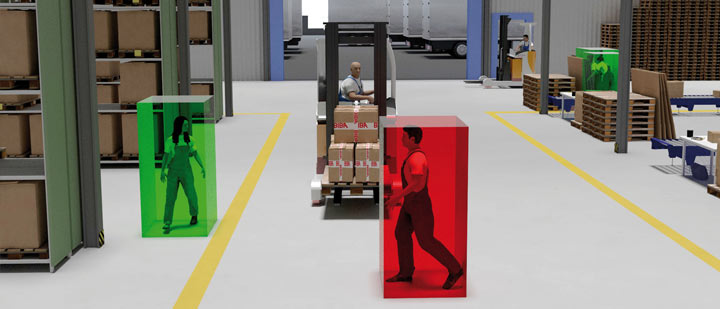PräVISION
Development of methods for the preventive increase of work safety on industrial trucks with implementation of an assistance system by fusion and analysis of 2D and 3D image data
Every accident at work is a personal fate and at the same time an economic loss for the employer as well as for society. If it is possible to identify potential hazardous situations in the company at an early stage, preventive measures can be taken to avoid or at least reduce the severity of the resulting accident.
The use of motor-driven industrial trucks in internal transport (e.g. forklift trucks) involves a high risk potential. Ignorance on the part of the driver or persons in the vicinity of the vehicle, high time pressure, poor visibility or a combination of these are frequent causes of accidents at work in which employees suffer damage. Driver assistance systems for industrial trucks can be used here to increase the attention of potentially affected employees at the decisive moment of the occurrence of a hazard and thus to warn the persons involved.
As part of the PräVISION research project funded by the German Social Accident Insurance (DGUV), suitable assistance systems for accident prevention on industrial trucks are being identified and their feasibility examined on the basis of suitable sensor technologies. A high number of accidents involving forklift trucks is caused by "human error" and mainly affects collisions of an industrial truck with objects and persons. A warning device that alerts the driver of a forklift truck to the danger of a collision in good time could in future prevent many accidents caused by collisions or at least mitigate their consequences.
The objective of the project is on the one hand to demonstrate basic methods for increasing occupational safety when using motor-driven FFZs. On the other hand, the application of 2D and 3D image processing in a demonstrator assistance system will prove that occupational safety can be increased. The combination of both image processing technologies makes it possible to combine the respective strengths of both optical technologies. The 2D image data can be used to identify contours and textures, with 3D images providing information on spatial relationships. Thus, for example, the danger zone can be automatically segmented on the basis of the spatial information of the 3D image data without great effort and then analyzed using the robust and established methods of 2D image processing. Thus the basics for a manufacturer-independent assistance system in form of a demonstrator are developed, which is retrofittable for any FFZ of different manufacturers and can find its future use thus industry-spreading. In addition, conceptual perspectives and approaches will be shown that enable a scaling of the assistance system to a safety system. For this purpose, chains of action are investigated in order to identify weak points and redundancies in the system and to describe them in a security concept.
In a first step, hazardous situations for persons in the vicinity of FFZ are analysed and evaluated with the aim of identifying assistance functions which can help to reduce important main causes of these hazards. Subsequently, a system will be conceptually designed to implement the previously identified assistance function. For this purpose, both the requirements for the system itself are specified and test cases for system evaluation are designed. An important role in the selection and development of algorithms is played by simulated operational data for the later assistance system, which can be used to evaluate the analysis procedures at an early stage. These simulated test data are used together with real field tests for system validation.
| AP | Title | Period |
|---|---|---|
| Project start | 03/15 | |
| 1 | Methods for increasing work safety at motor-driven FFZ | 03/15-11/15 |
| 2 | Requirements analysis and system design | 06/15-11/15 |
| 3 | Simulative determination of sensor selection and generation of test patterns | 06/15-05/16 |
| 4 | Methods for Hypothesis Formation | 03/16-11/16 |
| 5 | Methods for Image Analysis | 06/16-05/17 |
| 6 | System validation | 12/16-08/17 |
| 7 | Field tests | 06/17-11/17 |
| Project end | 11/17 |
